- 1Exercise Sciences Research Group, Tokyo Metropolitan Institute of Gerontology, Tokyo, Japan
- 2Food Research Department, Yakult Central Institute, Tokyo, Japan
- 3Microbiological Research Department, Yakult Central Institute, Tokyo, Japan
- 4Basic Research Department, Yakult Central Institute, Tokyo, Japan
- 5Faculty of Kinesiology and Physical Education, University of Toronto, Toronto, ON, Canada
Infrequent bowel movements decrease the number of beneficial bacteria in the human intestines, thereby potentially increasing the individual’s risk of colorectal cancer. The correction of such bowel problems could therefore make an important contribution to improving population health and quality-adjusted lifespan. We examined independent and interactive effects upon the fecal microbiota of two potentially favorable determinants of intestinal motility: the intake frequency of a fermented milk product containing Lactobacillus casei strain Shirota (LcS) and the quantity/quality of habitual physical activity in 338 community-living Japanese aged 65–92 years. Subjects were arbitrarily grouped on the basis of questionnaire estimates of LcS intake (0–2, 3–5, and 6–7 days/week) and pedometer/accelerometer-determined patterns of physical activity [<7000 and ≥7000 steps/day, or <15 and ≥15 min/day of activity at an intensity >3 metabolic equivalents (METs)]. After adjustment for potential confounders, the respective numbers of various beneficial fecal bacteria tended to be larger in more frequent consumers of LcS-containing products, this trend being statistically significant (mostly P < 0.001) for total Lactobacillus, the Lactobacillus casei subgroup, and the Atopobium cluster; in contrast, there were no statistically significant differences in fecal bacterial counts between the physical activity groups. A multivariate-adjusted logistic regression analysis estimated that the risk of infrequent bowel movements (arbitrarily defined as defecating ≤3 days/week) was significantly lower (P < 0.05) in subjects who ingested LcS-containing products 6–7 rather than 0–2 days/week [odds ratio (95% confidence interval) 0.382 (0.149–0.974)] and was also lower in those who took ≥7000 rather than <7000 steps/day [0.441 (0.201–0.971)] or spent ≥15 rather than <15 min/day of physical activity at an intensity >3 METs [0.412 (0.183–0.929)]. The risk of infrequent bowel movements in subjects who combined 6–7 days/week of LcS with ≥7000 steps/day or ≥15 min/day of activity at >3 METs was only a tenth of that for individuals who combined 0–2 days/week of LcS with <7000 steps/day or <15 min/day at >3 METs. These results suggest that elderly individuals can usefully ingest LcS-containing supplements regularly (≥6 days/week) and also engage in moderate habitual physical activity (≥7000 steps/day and/or ≥15 min/day at >3 METs) in order to enhance their gastrointestinal health.
Introduction
There are many different factors that affect human gastrointestinal health, including a healthy diet with a high fiber content. Certain types/species of microbiota are also important to gastrointestinal health, and the processes involved appear to be facilitated by the regular ingestion of fermented milk products containing lactic acid bacteria. A specific bacterium, the Lactobacillus casei strain Shirota (LcS) has been used in the production of fermented milk for more than 80 years, and products containing LcS have become very popular both in Japan and world-wide; respective consumptions averaged about 8 and 37 million bottles per day in the year 2016 (Yakult Honsha Co. Ltd., 2017).
Clinical trials have shown that LcS has many beneficial effects, including protection against infection (Gleeson et al., 2011; Nagata et al., 2011; Sur et al., 2011; Shida et al., 2017), enhanced immunoregulation (Nagao et al., 2000; Tamura et al., 2007), a reduced risk of carcinogenesis (Aso et al., 1995; Ohashi et al., 2002; Ishikawa et al., 2005; Toi et al., 2013), and the control of blood pressure (Nakajima et al., 1995; Aoyagi et al., 2017). Moreover, ingestion of LcS enhances intestinal motility, facilitating defecation in young and middle-aged individuals with either hard or soft stools (Matsumoto et al., 2006, 2010; Shioiri et al., 2006; Sakai et al., 2011). However, the impact of regular LcS ingestion on the risk of sustained problems of bowel movement in ostensibly healthy community-dwelling older people merits further epidemiological study.
Infrequent bowel movements reduce a person’s quality of life, and can have serious medical and social impacts (Johanson and Kralstein, 2007). The cumulative incidence of chronic constipation is higher in the elderly than in younger people (Choung et al., 2007). In 2016, 7.4% of Japanese elderly people (6.5% for men and 8.1% for women) complained of constipation (Ministry of Health, Labour and Welfare, Japan, 2016a). One immediate concomitant of infrequent bowel movements is a decrease of beneficial bacteria such as Bifidobacterium, Lactobacillus, and Roseburia species in the intestinal microbiota (Khalif et al., 2005; Kim et al., 2015; Mancabelli et al., 2017), with a resultant increase in the intestinal production of toxic and mutagenic compounds such as phenol and p-cresol, and a decrease in concentrations of butyric acid, a known anticancer substance (Ara et al., 2002; Nakabayashi et al., 2011; Kano et al., 2013). These changes could potentially increase the risk of colorectal cancer (Kotake et al., 1995; Le Marchand et al., 1997; Jacobs and White, 1998; Roberts et al., 2003), which has now become the leading cause of death among the Japanese (Ministry of Health, Labour and Welfare, Japan, 2016b).
Studies in the prevention and control of constipation (Sandler et al., 1990; Dukas et al., 2003; De Schryver et al., 2005) have to date suggested an association between inadequate habitual physical activity and infrequent bowel movements, although most investigations of this topic have been based simply upon questionnaire reports of exercise frequency per week. In consequence, there remains a need to define relationships between accurate objective measurements of habitual physical activity, defecation patterns and intestinal microbiota, particularly in the elderly, where both low levels of physical activity and constipation are frequent issues. Over an 18-year period since 2000, we have been conducting an epidemiological study in the community of Nakanojo Town, Gunma Prefecture, Japan (the Nakanojo Study), monitoring patterns of habitual physical activity in people aged 65 years and older (Aoyagi and Shephard, 2009, 2010, 2011, 2013). Accurate objective measurements of physical activity have been made 24 h per day, 365 days a year, using a physical activity monitor with a built-in accelerometer, and these data provide an exciting opportunity to explore associations between habitual activity and intestinal health.
The purpose of the present study was thus to examine associations between the intake frequency of fermented milk products containing LcS, the quantity and quality of habitual physical activity, and the intestinal health of free-living older people.
Materials and Methods
Subjects
The subjects were 140 male and 198 female self-supporting and independent Japanese volunteers aged 65–92 years who had been recruited to the Nakanojo Study (Aoyagi and Shephard, 2009, 2010, 2011, 2013). Subjects gave their written informed consent to participation in a study approved by the ethics review committee of the Tokyo Metropolitan Institute of Gerontology, after the protocol, stresses, and possible risks had been fully explained to them. Criteria of recruitment included attendance at an annual medical examination, functional independence, and the absence of chronic or progressive conditions that could limit physical activity or have a major effect on the individual’s perceived quality of life (e.g., cancer, arthritic diseases, Parkinson’s disease, Alzheimer’s disease, multiple sclerosis, amyotrophic lateral sclerosis, and dementia).
Estimation of the Frequency of Ingestion of Fermented Milk Products
The frequency of ingestion of fermented milk products containing LcS was estimated by a self-administered questionnaire with pictures of a series of commercially available LcS-containing products, including “Yakult”, “Joie”, “Soful”, and “Pretio” (Yakult Honsha Co. Ltd., Minato, Tokyo, Japan), each of which contains 0.9–40 billion live LcS per bottle. Subjects were asked how many days per week they had ingested products of the type illustrated over a 1-month period before the collection of fecal samples. The frequency of intake of general fermented milk products, such as yogurt (including the above Yakult Honsha Co. Ltd. products), was estimated in the same manner (see Supplementary Table 1). Subjects were classed as consuming a bottle of the product 0–2 days/week (designated as “group 0–2”), 3–5 days/week (designated as “group 3–5”), or 6–7 days/week (designated as “group 6–7”).
Measurement of Physical Activity Patterns
Physical activity patterns were measured for 24 h per day over a 1-month period, using a uniaxial acceleration sensor (Lifecorder; Suzuken Co. Ltd., Nagoya, Aichi, Japan), as described previously (Aoyagi and Shephard 2009, 2010, 2011, 2013). The average number of steps taken per day and the daily cumulative duration of moderate-intensity exercise [activity demanding an energy expenditure greater than 3 metabolic equivalents (METs)] were calculated for each subject (see Supplementary Table 2). Subjects were classed as taking <7000 steps/day (designated as “group <7000”) or ≥7000 steps/day (designated as “group ≥7000”) and spending <15 min/day at >3 METs (designated as “group <15”) or ≥15 min/day at >3 METs (designated as “group ≥15”). As previously demonstrated (Aoyagi and Shephard, 2009, 2010, 2011, 2013), a series of cross-sectional and/or longitudinal analyses has shown a low prevalence and/or incidence of various chronic diseases and disorders (including cancer of the colon and rectum; Aoyagi and Shephard, 2011) in elderly individuals taking daily doses of physical activity above disease-specific thresholds.
Assessment of Anthropometric Characteristics and Blood Profiles
The physical characteristics of subjects (age, sex, height, body mass, body mass index, abdominal circumference, body fat percentage, fat mass, fat-free mass, and muscle mass) were determined by standard anthropometric techniques (Shephard et al., 2013). Biochemical profiles (triglyceride, high-density lipoprotein cholesterol, low-density lipoprotein cholesterol, glycosylated hemoglobin A1c, blood sugar, glutamic oxaloacetic transaminase, glutamic pyruvic transaminase, γ-glutamyl transpeptidase, albumin, creatinine, uric acid concentrations, and the estimated glomerular filtration rate) were also measured by standard methods (Health Sciences Research Institute Inc., Yokohama, Kanagawa, Japan).
Examination of Physical Health
Blood pressure was measured after 5 min of seated rest, using an automatic sphygmomanometer (BP-103iII; Colin Medical Technology Co. Ltd., Komaki, Aichi, Japan). At least one further measurement was made after a further 5 min of rest if the initial reading suggested that an individual had become hypertensive (or rarely, hypotensive). Preferred and maximal walking speeds were determined over a 5-m distance, using a stopwatch (SVAE101; Seiko Corp., Minato, Tokyo, Japan), as described previously (Aoyagi et al., 2004). Subjects completed two trials to determine each of comfortable and maximal walking speeds; the averaged and the higher velocities were each recorded for each of the two measurements. Peak handgrip force was assessed for the dominant hand, using a Smedley dynamometer (ES-100; Evernew Co. Ltd., Koto, Tokyo, Japan). Two trials were performed, and the larger of the two readings was noted. Quantitative ultrasound measurements of osteosonic index for the calcaneus were made using an Achilles ultrasonic bone densitometer (AOS-100; Aloka Co. Ltd., Mitaka, Tokyo, Japan), as described previously (Shephard et al., 2017).
Investigation of Nutrient Intake
The nutritional status of the subjects was evaluated by a certified nutritionist over a 1-week period, using Version 3.5 of the Food Frequency Questionnaire Based on Food Groups (FFQg; Kenpakusha Co. Ltd., Bunkyo, Tokyo, Japan), which is a 20-item questionnaire regarding the consumption of items from 29 food groups and 10 methods of food preparation. On the basis of responses to this questionnaire, the daily intake of energy, nutrients, and food groups was estimated for the 1- to 2-month period prior to the start of the study. The estimated nutrients included protein, lipid, carbohydrate, dietary fiber, saturated fatty acids, monounsaturated fatty acids, polyunsaturated fatty acids, cholesterol, sodium, potassium, calcium, magnesium, iron, and vitamin C.
Collection and Treatment of Fecal Samples
Subjects collected freshly excreted stool samples of around 500 mg into sterile feces tubes (Sarstedt AG & Co., Nümbrecht, Nordrhein-Westfalen, Germany) containing 2 ml of a ribonucleic acid (RNA) stabilization solution (RNAlater; Ambion Inc., Austin, TX, United States). Samples were kept at room temperature and sent to the Yakult Central Institute within a couple of days. After arrival at the Institute, they were stored at 4°C in a biosafety level 2 laboratory until processing. Fecal samples were weighed, suspended in nine volumes of RNAlater, and then homogenized. The fecal homogenate (200 μl) was added to 1 ml of sterilized phosphate-buffered saline and then centrifuged at 10,000 × g for 5 min. The supernatant was discarded, and the pellet was stored at −80°C until RNA and deoxyribonucleic acid (DNA) extraction.
Assay of Gut Microbiota
The number of each of the many bacteria detected in the gut was determined by the reverse transcription-quantitative polymerase chain reaction (RT-qPCR) technique (Matsuda et al., 2007, 2009, 2012; Kubota et al., 2010; Tsuji et al., 2012; Nagpal et al., 2016; Suzuki et al., 2017), using the Yakult Intestinal Flora Scan (YIF-SCAN; Yakult Honsha Co. Ltd., Minato, Tokyo, Japan). In the preliminary/preparatory stages of this determination, RNA was isolated from fecal samples, as described previously (Matsuda et al., 2012), and it was used for RT-qPCR. The specificity and sensitivity of RT-qPCR analysis for selected gut bacteria using group-, genus-, species-, and strain-specific primer sets have been described previously (Matsuda et al., 2007, 2009, 2012). Base sequences of the primer sets, annealing temperatures, and minimum detection limits for quantification of the bacteria are shown in Supplementary Table 3. A detection limit was assigned for the statistical calculation of fecal bacterial counts. Two beneficial bacteria (Lactobacillus and Bifidobacterium), four pathogenic bacteria (Pseudomonas, Staphylococcus, Clostridium difficile, and Clostridium perfringens), five obligate anaerobes (Atopobium cluster, Bacteroides fragilis group, Clostridium coccoides group, Clostridium leptum subgroup, and Prevotella), and three facultative anaerobes (Enterobacteriaceae, Enterococcus, and Streptococcus) were selected because of their predominance in the intestines of healthy Japanese people (Matsuda et al., 2009; Tsuji et al., 2012, 2018). Total Lactobacillus (L.) was calculated as the sum of the counts of six subgroups (L. casei, L. gasseri, L. plantarum, L. reuteri, L. ruminis, and L. sakei) and two species (L. fermentum and L. brevis). On the other hand, the relative abundances of the fecal bacteria families were determined by amplicon analysis targeting the 16S ribosomal RNA (rRNA) gene, as described previously (Kato-Kataoka et al., 2016), using the Quantitative Insights Into Microbial Ecology (QIIME) software (Caporaso et al., 2010). In brief, DNA was isolated from fecal samples (Fujimoto et al., 2008), and the V1-V2 region of the 16S rRNA gene of gut microbiota was amplified using the forward 27Fmod2-MiSeqV2 and the reverse 338RMiSeqV2-001 primers (see Supplementary Table 4 for details) to monitor DNA amplification in a real-time PCR (Applied Biosystems 7500; Life Technologies Japan Ltd., Minato, Tokyo, Japan). The amplified DNA was purified using a PCR product purification kit (Agencourt AMPure XP; Beckman Coulter K. K., Koto, Tokyo, Japan), quantified using a double-stranded DNA (dsDNA) assay kit (Quant-iT PicoGreen dsDNA; Life Technologies Japan Ltd., Minato, Tokyo, Japan), and sequenced using a MiSeq sequencing system (Illumina K. K., Minato, Tokyo, Japan).
Evaluation of Defecation
The frequency of defecation was estimated by a self-administered questionnaire. Subjects were asked how many days they had defecated over a 1-week period before the fecal sampling. Infrequent bowel movements were arbitrarily defined as defecating 3 days or less per week. The consistency of the stools was estimated using the Bristol Stool Form Scale (BSFS; Heaton et al., 1992), a diagnostic tool designed to classify the shape and type of human feces into seven distinct categories: separate hard lumps, like nuts (=1); sausage-shaped, but lumpy (=2); like a sausage, but with cracks on its surface (=3); like a sausage or snake, smooth and soft (=4); soft blobs with clear-cut edges (=5); fluffy pieces with ragged edges, a mushy stool (=6); and watery, no solid pieces, entirely liquid (=7).
Statistical Analyses
Version 23.0 of the IBM SPSS Statistics (IBM Corp., Armonk, NY, United States) was used throughout. Subjects were divided into arbitrary groups, based on the reported frequency of ingestion of fermented milk products (0–2, 3–5, and 6–7 days/week) and the pattern of habitual physical activity (<7000 and ≥7000 steps/day, or <15 and ≥15 min/day at >3 METs). Analyses of covariance assessed independent differences among or between groups with respect to anthropometry, supplement consumption, physical activity, physical health, nutrition, blood, fecal microbiota, and fecal characteristics, after controlling data for age, sex, body mass index, smoking status, and/or alcohol consumption. Chi-square tests assessed differences in male/female ratio and the rate of infrequent bowel movements among and/or between groups. Logistic regression analyses determined odds ratios and 95% confidence intervals adjusted for age, sex, body mass index, smoking status and alcohol consumption, and assessed independent relationships between fermented milk product intakes and/or daily physical activity patterns and the estimated risk of infrequent bowel movements. All statistical contrasts were made at the 0.05 level of significance, although the appropriate Tukey correction was applied when multiple comparisons were made.
Results
Two hundred and four, 54, and 80 of the 338 subjects consumed fermented milk products containing LcS (as manufactured by the Yakult Honsha Company) 0–2, 3–5, and 6–7 days/week, respectively; with respect to overall fermented milk products, the corresponding numbers were 78, 70, and 190 of the 338 participants (Supplementary Table 1). In terms of habitual physical activity, 187 and 151 of the 338 subjects took <7000 and ≥7000 steps/day, respectively, and 188 and 150 of subjects spent <15 and ≥15 min/day of physical activity at an intensity >3 METs, respectively (Supplementary Table 2). Associations with nutrition and intestinal health, particularly the frequency of defecation, were similar for the various methods of classifying our sample, and we thus limit the discussion of findings mainly in relation to the ingestion of LcS-containing fermented milk products and the duration of physical activity >3 METs.
Initially, there were no statistically significant differences among 0–2, 3–5, and 6–7 LcS consumption groups with respect to any of the variables examined, except age and the intake of a few nutrients (potassium, calcium, and iron). The most frequent users of LcS were older and tended to be better nourished than their peers (Table 1). However, statistically significant differences were found between <15 and ≥15 physical activity groups in terms of age, body mass, abdominal circumference, body fat percentage, fat mass, preferred and maximal walking speeds; physically more active subjects were younger, less fat, and faster walkers (Table 2). Current smokers were 16 of 204 in the LcS group 0–2, 2 of 54 in the LcS group 3–5, 3 of 80 in the LcS group 6–7, 11 of 188 in the activity group <15, and 10 of 150 in the activity group ≥15. Moderate alcohol consumption was reported by 83 of 204 subjects in group 0–2, 21 of 54 subjects in group 3–5, 22 of 80 subjects in group 6–7, 62 of 188 subjects in group <15, and 64 of 150 subjects in group ≥15, with the remaining subjects not consuming significant amounts of alcohol.
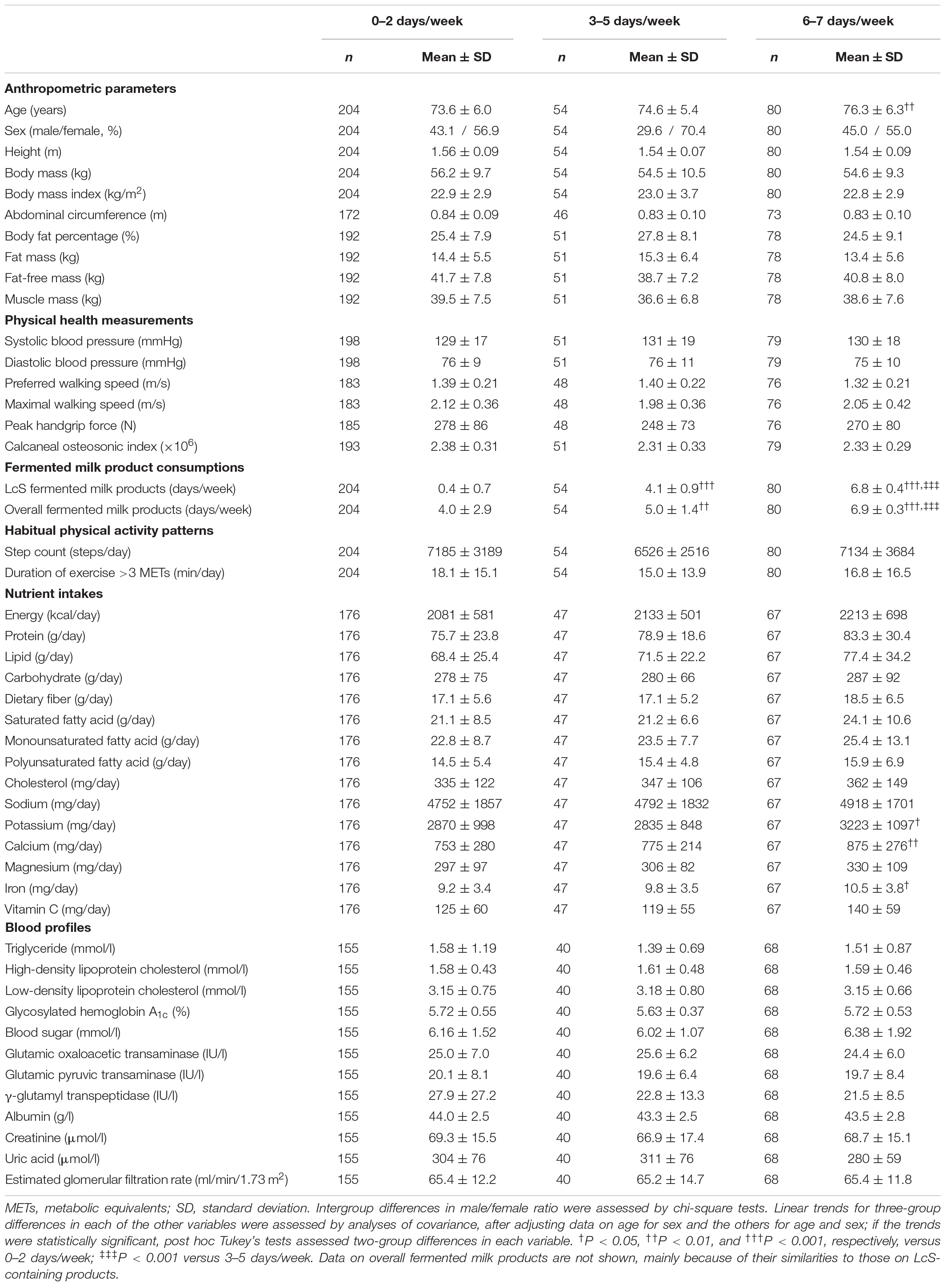
Table 1. Characteristics of subjects consuming fermented milk products containing Lactobacillus casei strain Shirota (LcS) 0–2, 3–5, or 6–7 days per week.
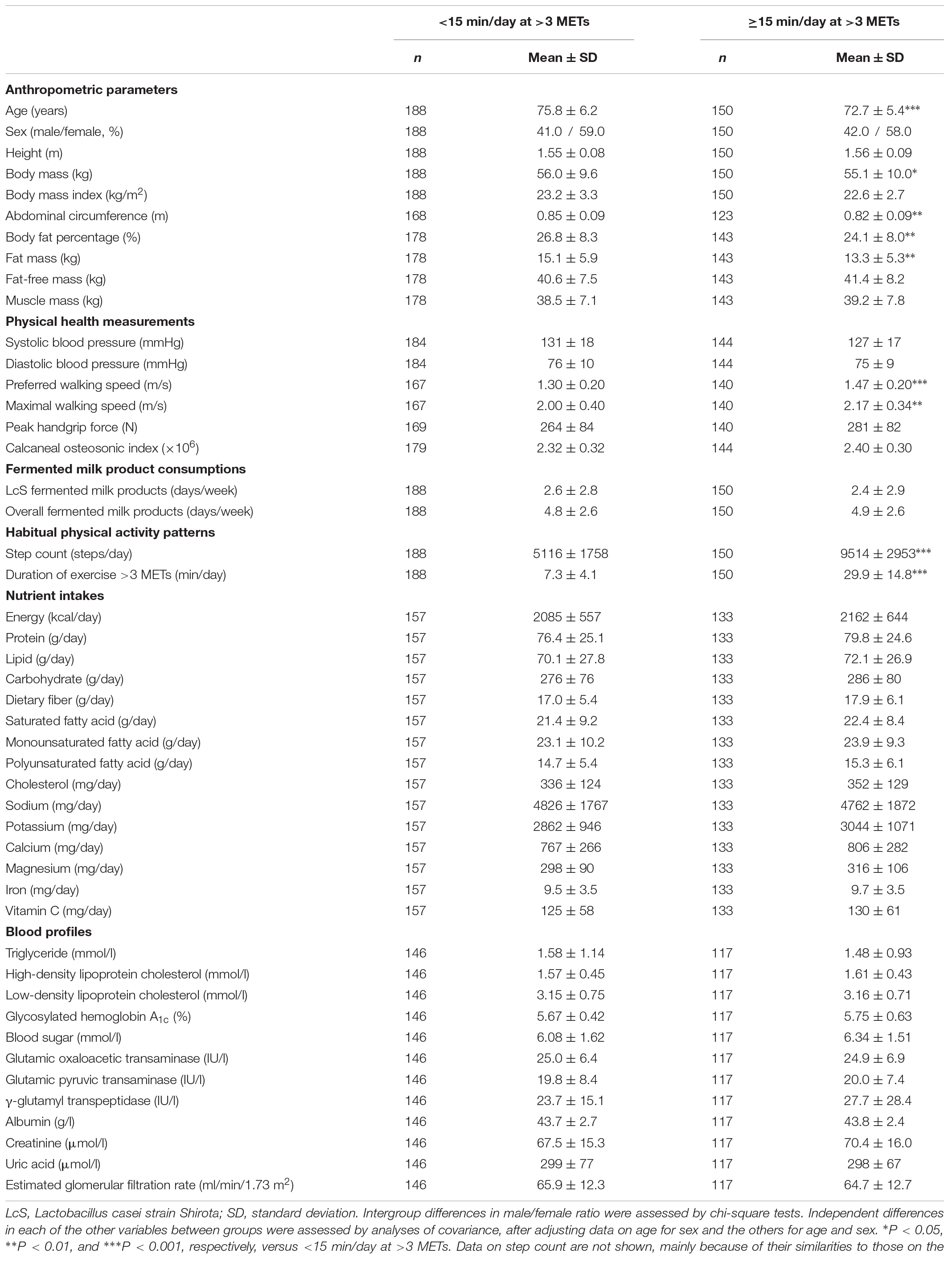
Table 2. Characteristics of subjects taking exercise demanding an energy expenditure >3 metabolic equivalents (METs) for <15 or ≥15 min per day.
The number of each of many bacteria detected in the intestines tended to be larger in the more frequent consumers of LcS-containing products, this trend being statistically significant for total Lactobacillus (groups 0–2 versus 3–5 and 6–7), the Lactobacillus casei subgroup (groups 0–2 versus 3–5 and 6–7; groups 3–5 versus 6–7), and the Atopobium cluster (groups 0–2 versus 6–7) (Figure 1 and Supplementary Table 5). On the other hand, there were no statistically significant differences between <15 and ≥15 physical activity groups with respect to counts for any of the selected fecal bacteria (Figure 2 and Supplementary Table 6). Furthermore, there were no significant intergroup differences in the relative abundance of any of the fecal bacteria families (limited to a share ≥0.1%) except Bacillaceae (LcS groups 0–2 versus 3-5; activity groups <15 versus ≥15) and Fusobacteriaceae (activity groups <15 versus ≥15) (Figures 3, 4 and Supplementary Tables 7, 8).
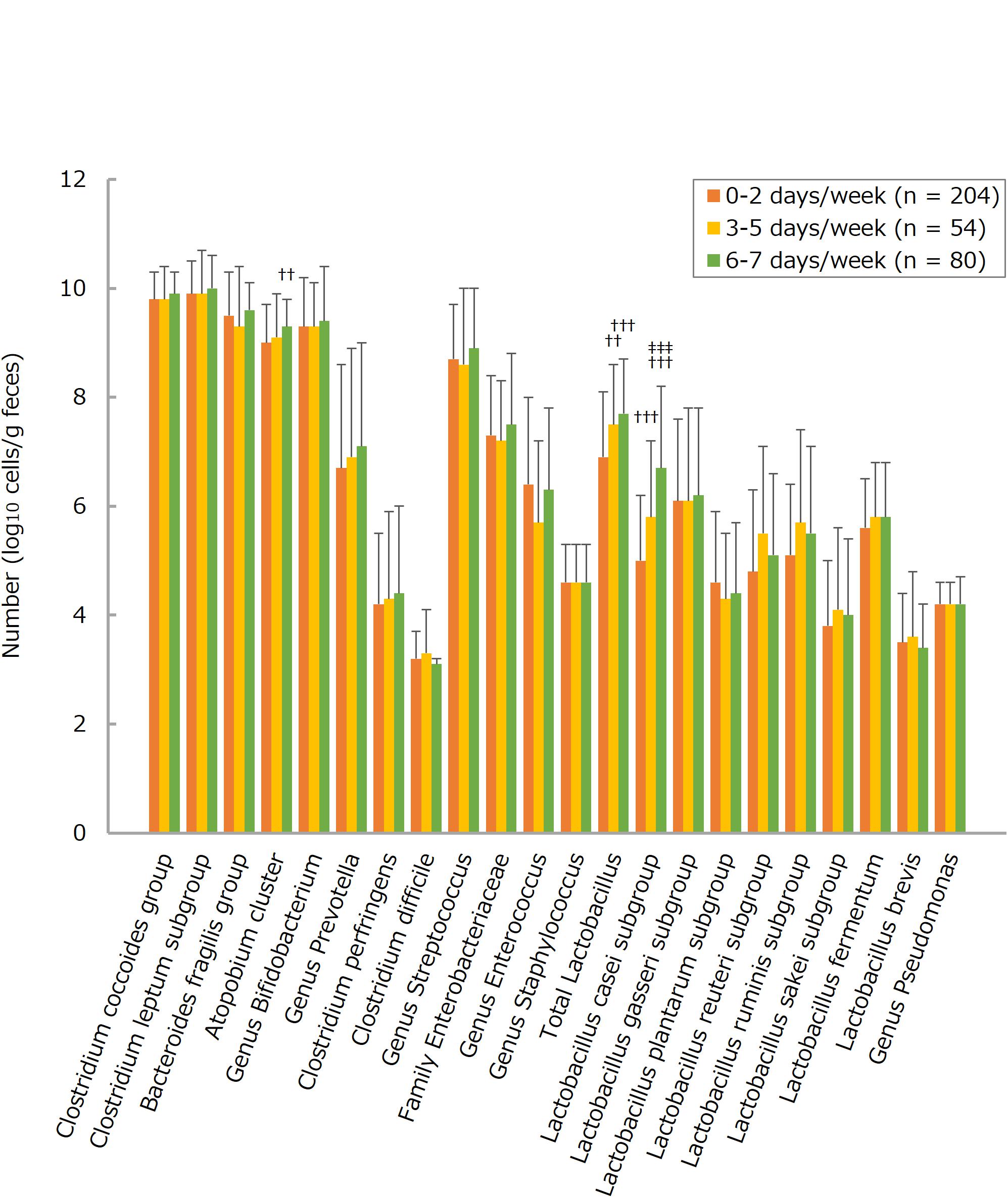
Figure 1. Numbers of fecal microbiota in subjects consuming fermented milk products containing Lactobacillus casei strain Shirota (LcS) 0–2, 3–5, or 6–7 days per week. Values are means ± standard deviations. Linear trends for three-group differences in each bacterial count were assessed by analyses of covariance, after adjusting data for age, sex, body mass index, smoking status, and alcohol intake; if the trends were statistically significant, post hoc Tukey’s tests assessed two-group differences in each bacterial count. ††P < 0.01 and †††P < 0.001, respectively, versus 0–2 days/week; ‡‡‡P < 0.001 versus 3–5 days/week. Data on overall fermented milk products are not shown, mainly because of their similarities to those on LcS-containing products.
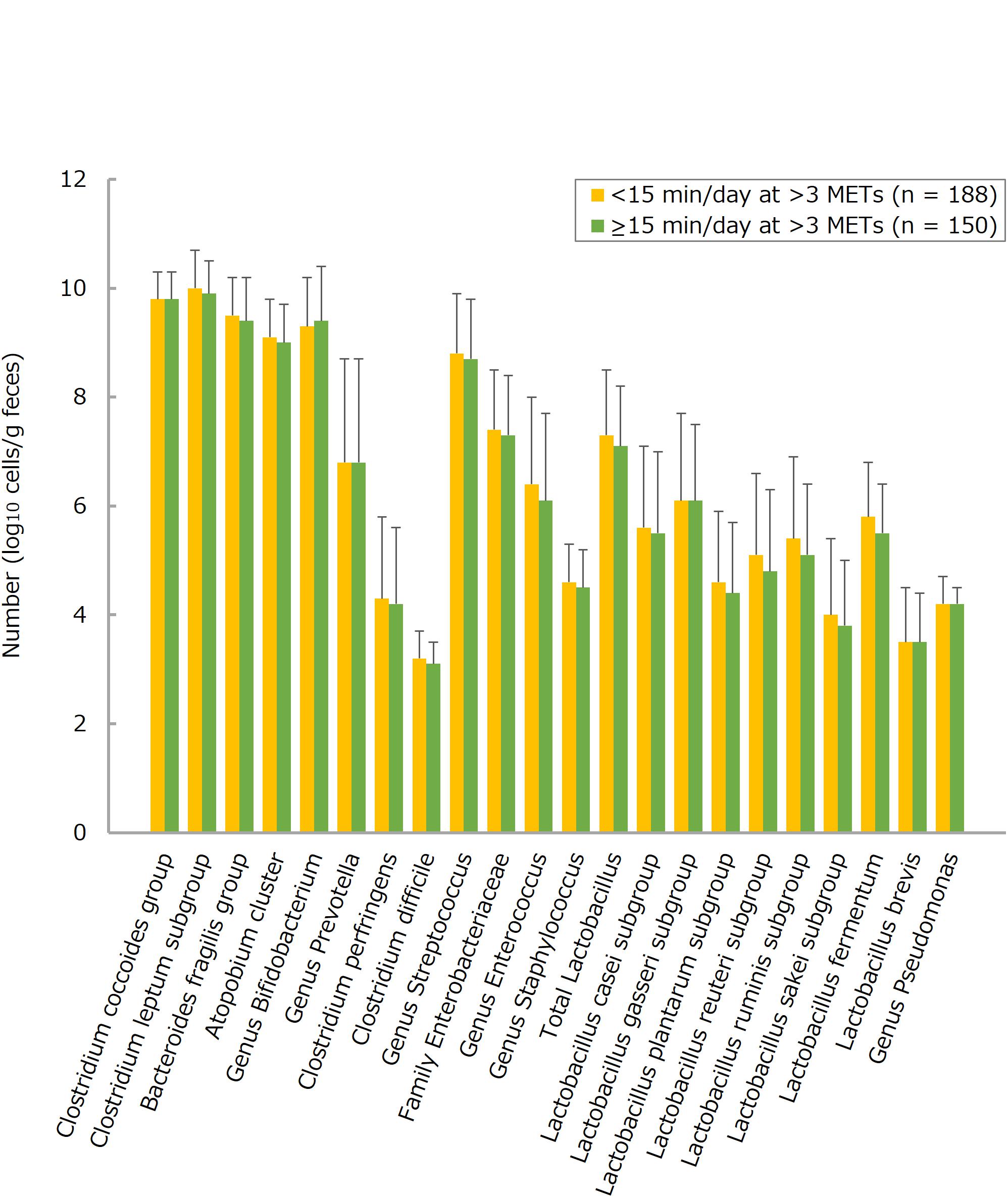
Figure 2. Numbers of fecal microbiota in subjects taking exercise demanding an energy expenditure >3 metabolic equivalents (METs) for <15 or ≥15 min per day. Values are means ± standard deviations. Independent differences in each bacterial count between groups were assessed by analyses of covariance, after adjusting data for age, sex, body mass index, smoking status, and alcohol intake. Data on step count are not shown, mainly because of their similarities to those on the duration of exercise >3 METs.
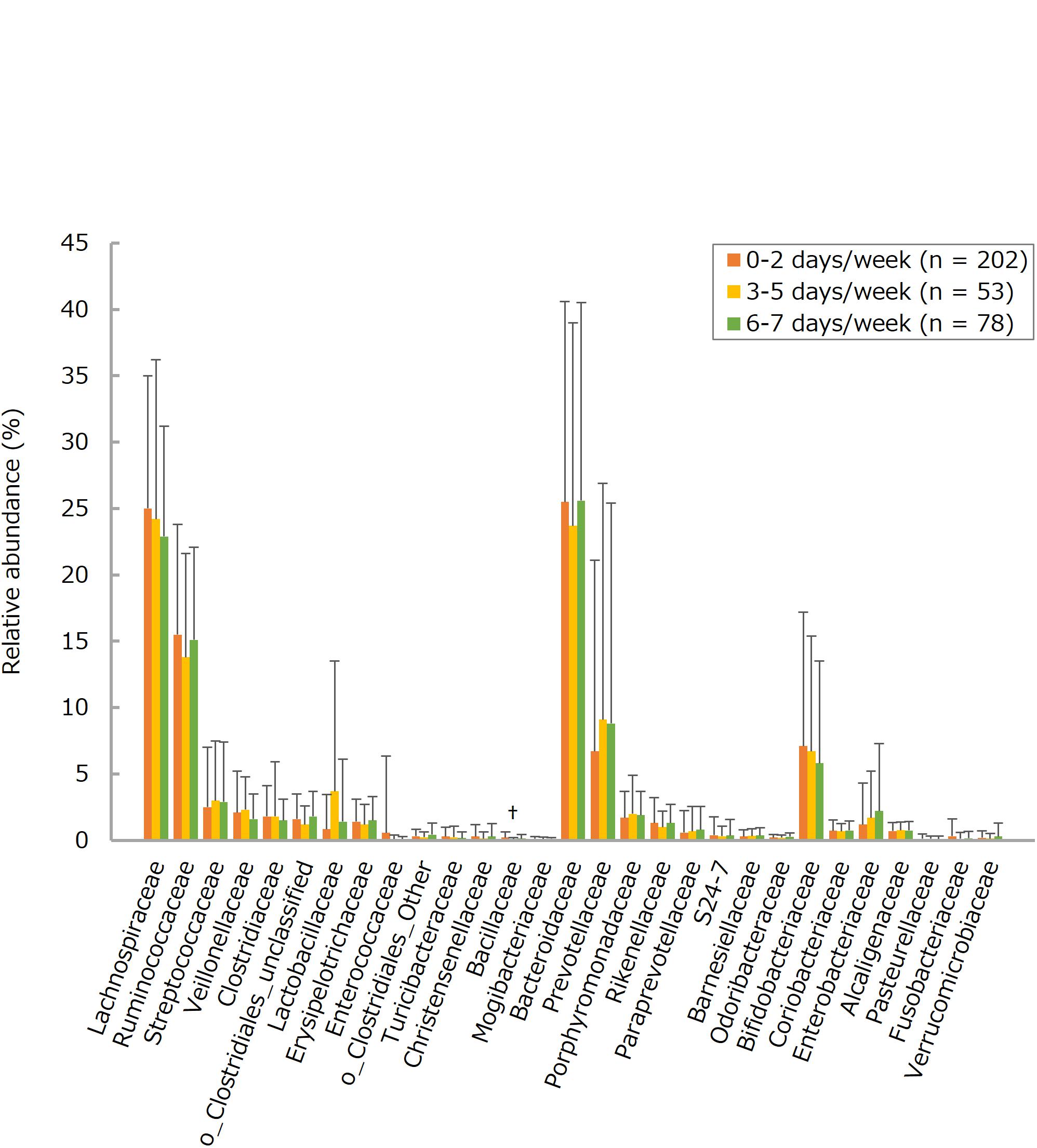
Figure 3. Relative abundances of the fecal bacteria families (limited to a share ≥0.1%) in subjects consuming fermented milk products containing Lactobacillus casei strain Shirota (LcS) 0–2, 3–5, or 6–7 days per week. Values are means ± standard deviations. Linear trends for three-group differences in each bacterial abundance were assessed by analyses of covariance, after adjusting data for age, sex, body mass index, smoking status, and alcohol intake; if the trends were statistically significant, post hoc Tukey’s tests assessed two-group differences in each bacterial abundance. †P < 0.05 versus 0–2 days/week. Data on overall fermented milk products are not shown, mainly because of their similarities to those on LcS-containing products.
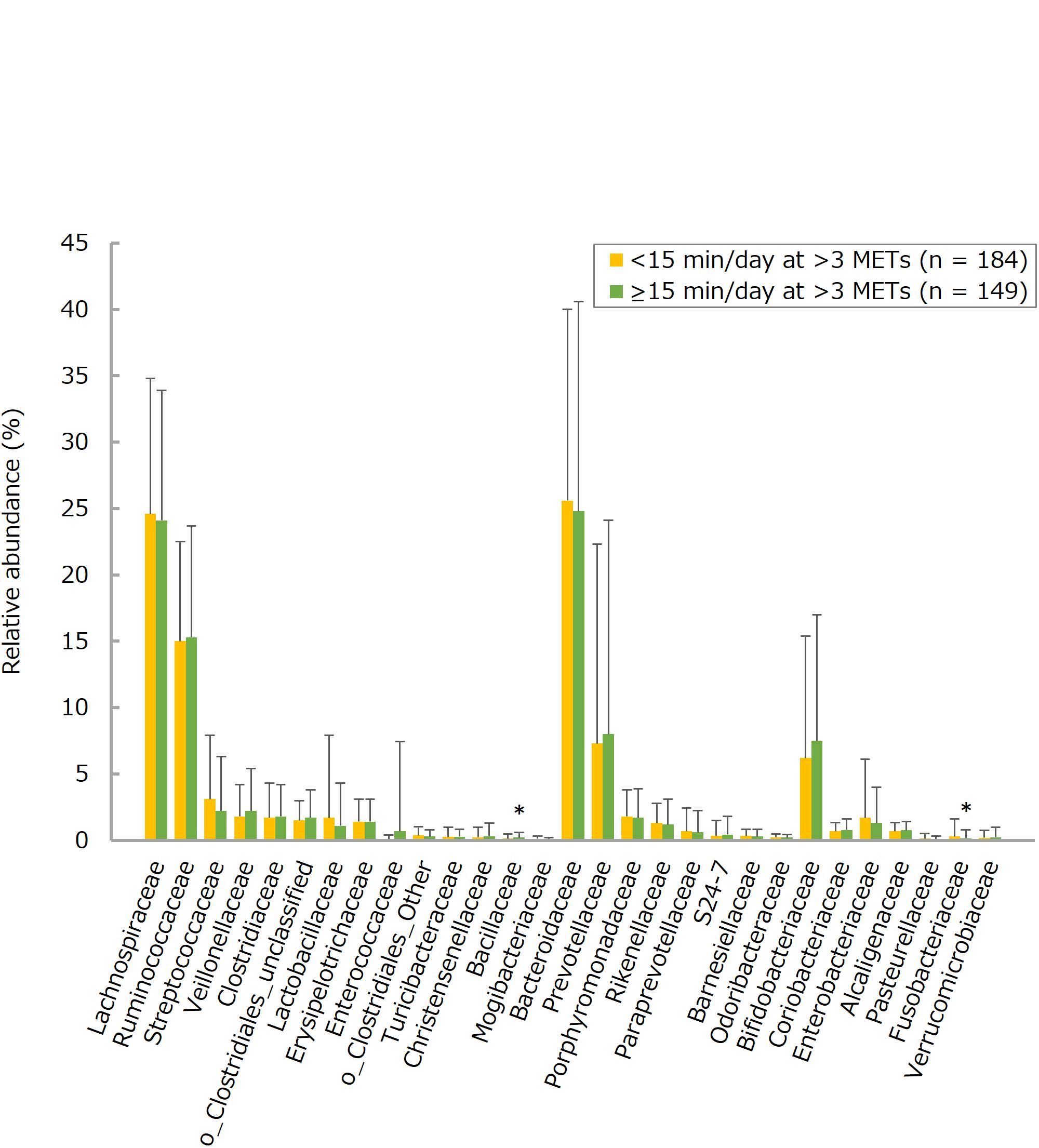
Figure 4. Relative abundances of the fecal bacteria families (limited to a share ≥0.1%) in subjects taking exercise demanding an energy expenditure >3 metabolic equivalents (METs) for <15 or ≥15 min per day. Values are means ± standard deviations. Independent differences in each bacterial abundance between groups were assessed by analyses of covariance, after adjusting data for age, sex, body mass index, smoking status, and alcohol intake. *P < 0.05 versus <15 min/day at >3 METs. Data on step count are not shown, mainly because of their similarities to those on the duration of exercise >3 METs.
Our population in general had regular and normal bowel movements, and in terms of the intake of both LcS and overall fermented milk products, no significant intergroup differences were observed in either the frequency of defecation or the consistency of the stools (Table 3). On the other hand, in terms of habitual physical activity, the frequency of defecation differed significantly both between <7000 and ≥7000 groups and between <15 and ≥15 groups, although there were no significant intergroup differences in BSFS rating (Table 4).
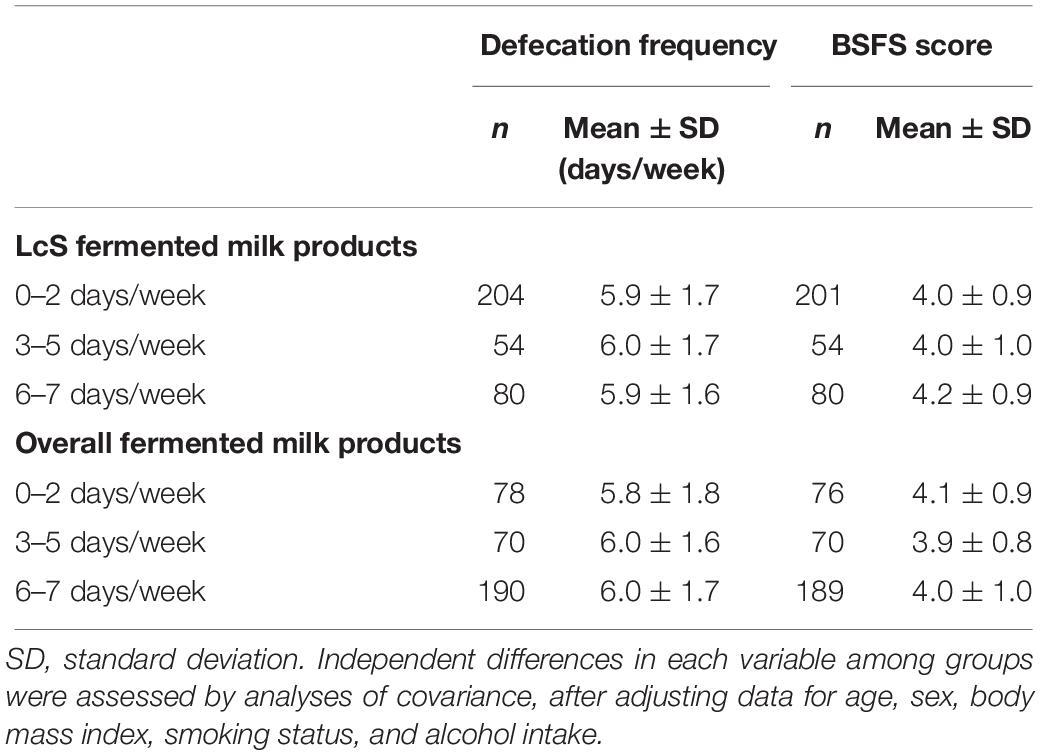
Table 3. Defecation frequency and scores on the Bristol Stool Form Scale (BSFS) in subjects consuming fermented milk products containing Lactobacillus casei strain Shirota (LcS) and overall fermented milk products 0–2, 3–5, or 6–7 days per week.
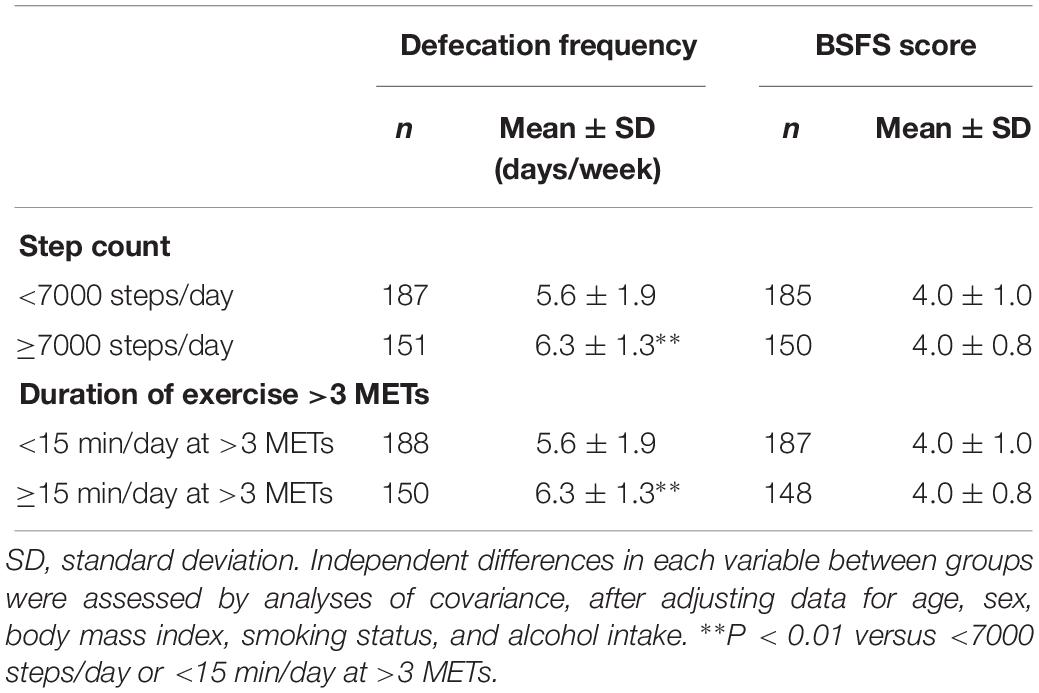
Table 4. Defecation frequency and scores on the Bristol Stool Form Scale (BSFS) in subjects taking <7000 or ≥7000 steps per day and spending <15 or ≥15 min per day of exercise at an intensity >3 metabolic equivalents (METs).
Relating defecation to LcS and overall supplement consumption, respectively, 29/204 (14.2%) and 14/78 (17.9%) of group 0–2, 5/54 (9.3%) and 8/70 (11.4%) of group 3–5, and 7/80 (8.8%) and 19/190 (10.0%) of group 6–7 had bowel movements ≤3 days/week (Table 5); the 5% and 8% differences in the prevalence of infrequent bowel movements between 0–2 and 6–7 groups became statistically significant after multivariate adjustment, with a substantial advantage to group 6–7 [respective odds ratios (95% confidence intervals) of 0.382 (0.149–0.974) and 0.314 (0.134–0.732)] relative to group 0–2 (Table 5). On the other hand, in terms of habitual physical activity, the analogous statistically significant figures were 10% and 11% [31/187 (16.6%) of group <7000 versus 10/151 (6.6%) of group ≥7000 and 32/188 (17.0%) of group <15 versus 9/150 (6.0%) of group ≥15, respectively], and 0.441 (0.201–0.971) in group ≥7000 relative to group <7000 and 0.412 (0.183–0.929) in group ≥15 relative to group <15 (Table 6).
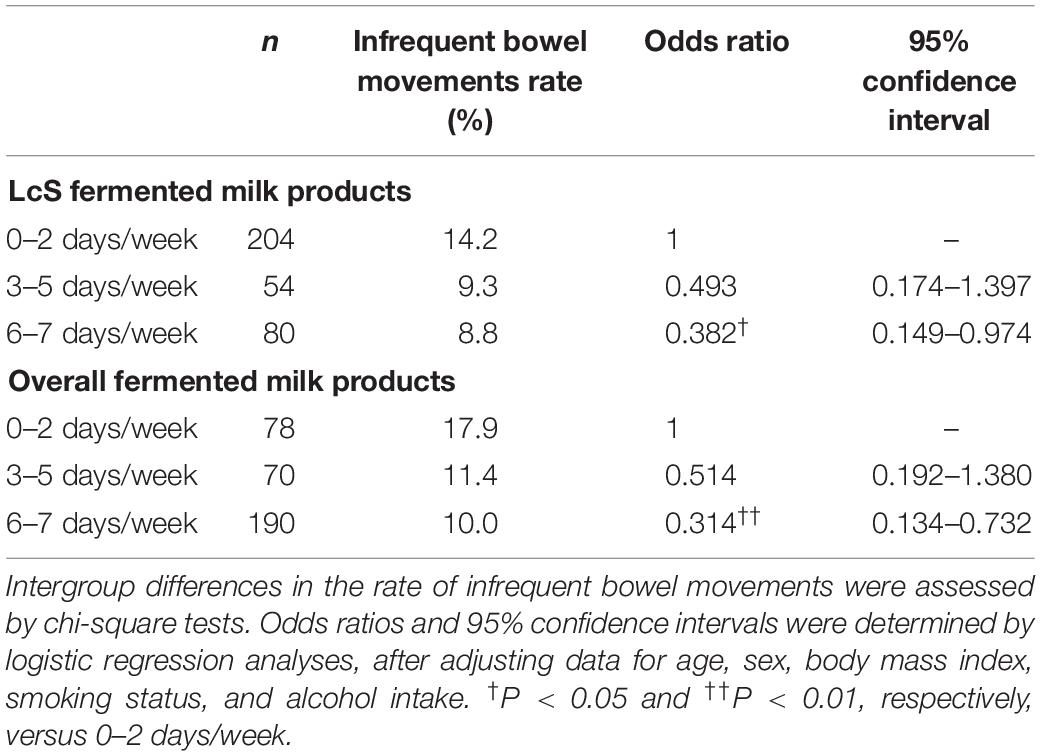
Table 5. Estimated risks of developing infrequent bowel movements in subjects consuming fermented milk products containing Lactobacillus casei strain Shirota (LcS) and overall fermented milk products 0–2, 3–5, or 6–7 days per week.
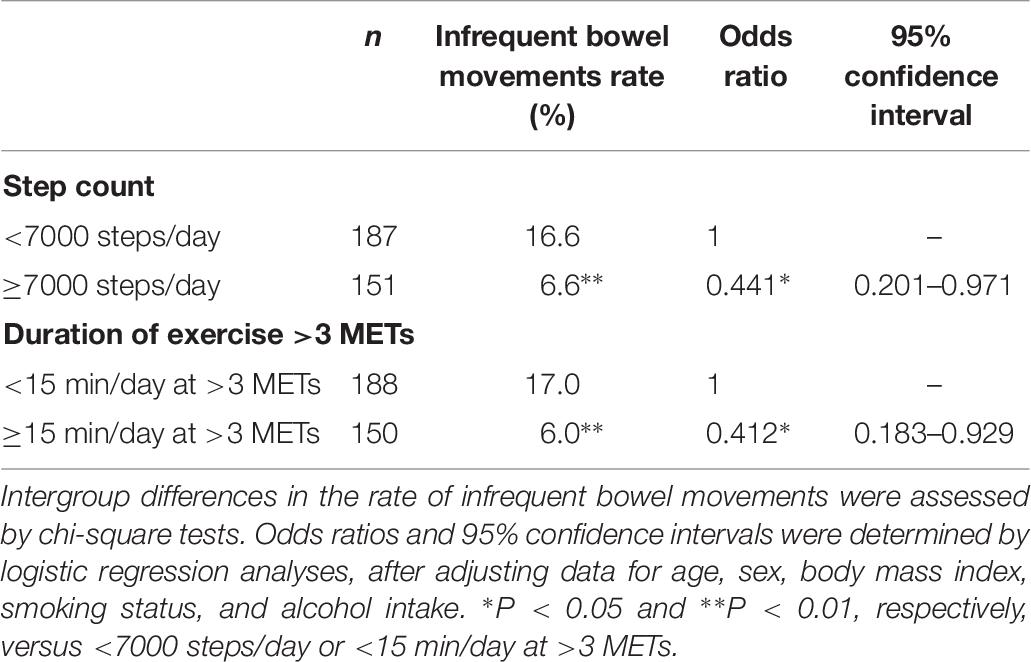
Table 6. Estimated risks of developing infrequent bowel movements in subjects taking <7000 or ≥7000 steps per day and spending <15 or ≥15 min per day of exercise at an intensity >3 metabolic equivalents (METs).
In terms of interactions between fermented milk product intakes and habitual physical activity patterns, there were tendencies to differences in the rate of infrequent bowel movements between combinations of variables (significantly so for 0–2 days/week × <7000 steps/day or <15 min/day at >3 METs versus some other combinations), although a small proportion of individuals taking LcS or overall fermented milk products 6–7 days/week and engaging in ≥7000 steps/day or exercise >3 METs for ≥15 min/day also had such bowel problems (Table 7). After multivariate adjustment, the estimated risks of demonstrating infrequent bowel movements tended to be lower if the frequency of supplement ingestion and/or the level of physical activity were/was greater. Using the least frequent and physically less active users of the products as the comparison group, the risk of such bowel problems was no more than one-fifth as large for subjects who consumed LcS-containing fermented milk products 6–7 days/week and took ≥7000 steps/day or spent <15 min/day of physical activity >3 METs, and it dropped to about one-tenth for those consuming overall fermented milk products 6–7 days/week and taking ≥7000 steps/day or spending both <15 and ≥15 min/day at >3 METs (Table 7).
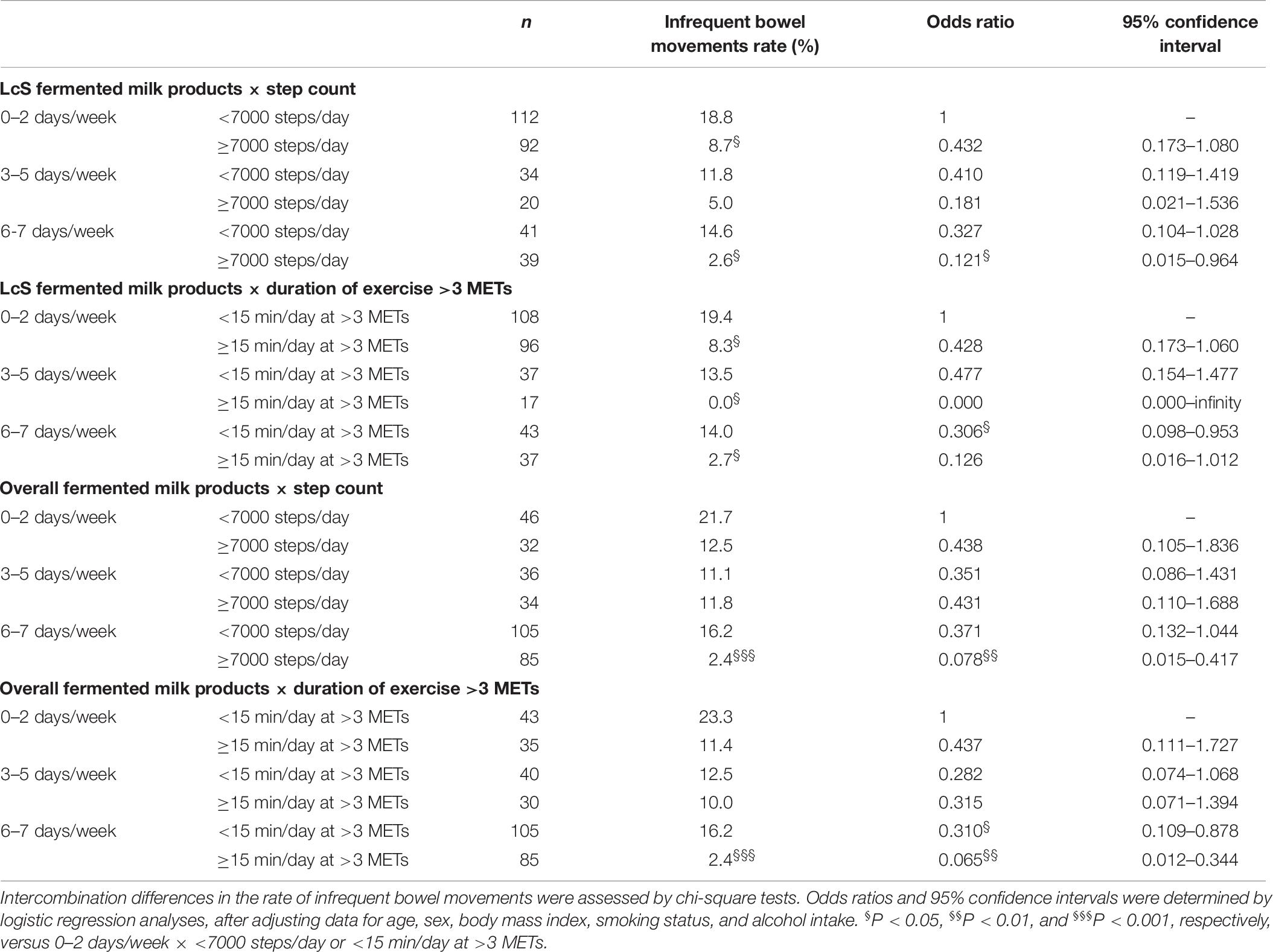
Table 7. Interactions between fermented milk product intakes and habitual physical activity patterns in terms of estimated risks of developing infrequent bowel movements in sample of 338 elderly Japanese.
Discussion
Clinical investigations to date have generally shown that either the daily intake of fermented milk products containing LcS (Matsumoto et al., 2006, 2010; Shioiri et al., 2006; Sakai et al., 2011) or regular engagement in physical activity or exercise (Sandler et al., 1990; Dukas et al., 2003; De Schryver et al., 2005) augments intestinal motility and/or induces favorable changes in the local microbiotal environment, and that this is associated with a reduced risk of infrequent bowel movements in young and middle-aged people. However, since the extent of the individual’s habitual physical activity has been estimated by relatively inaccurate questionnaires, the impact of LcS and objectively measured physical activity on such parameters remains to be clearly defined in healthy community-dwelling individuals. The present cross-sectional epidemiological study supports other clinical observations (Sandler et al., 1990; Dukas et al., 2003; De Schryver et al., 2005; Matsumoto et al., 2006, 2010; Shioiri et al., 2006; Sakai et al., 2011) in showing an association between the frequent ingestion of LcS or the regular performance of physical activity and a reduced risk of infrequent bowel movements. The new data confirm that in elderly people with no serious health problems, the likelihood of reporting infrequent bowel movements is lower in those with a higher habitual intake of LcS-containing fermented milk products and/or a greater quantity/quality of habitual physical activity.
There seems a tendency toward finding greater respective numbers of gut microbiota, especially total Lactobacillus and the Lactobacillus casei subgroup, as the frequency of ingesting LcS-containing fermented milk products is increased. Many clinical trials (Yuki et al., 1999; Matsumoto et al., 2006; Sakai et al., 2011; Suzuki et al., 2017) have also shown that a large fraction of the ingested population of LcS survives in the human gastrointestinal tract; this may be attributed to a high tolerance of LcS to gastric and bile acids (Kobayashi et al., 1974). In our subjects, most of whom had regular and normal bowel movements (on average about 6 days/week; an average BSFS score of about 4), no increases in the frequency of defecation or no improvements in the consistency of stool were seen in those ingesting LcS-containing supplements more frequently. Nevertheless, the likelihood of infrequent bowel movements (defined as defecating ≤3 days/week) was lowest in elderly individuals who consumed LcS-containing fermented milk products 6–7 days/week. In consequence, the estimated risk of such bowel problems in these individuals was about one-third [a significant odds ratio (95% confidence interval) of 0.382 (0.149–0.974)] after controlling data for potential confounders. These findings support the suggestion (as evaluated by a randomized, double-blind, placebo-controlled, crossover scheme; Matsumoto et al., 2006) that almost daily consumption of LcS-containing fermented milk products could benefit older people who tend to be constipated by increasing the intestinal population of beneficial microbes (Lactobacillus species) and raising the intestinal level of metabolites of microbial fermentation (lactic acids), thus stimulating intestinal peristalsis/motility (Matsumoto, 2013; Mai et al., 2017).
On the other hand, habitual physical activity (whether expressed as daily step count or daily duration at an intensity >3 METs) was not associated with the number of any of the fecal bacteria analyzed in the present investigation. However, there was a small but statistically significant difference of mean defecation frequency (<1 day/week) between physically more and less active individuals, irrespective of whether physical activity was expressed as daily step count or the duration of activity >3 METs. The prevalence of infrequent bowel movements was some ≥10% lower in elderly people who took ≥7000 steps/day or spent ≥15 min/day of physical activity >3 METs than in those with <7000 steps/day or <15 min/day of activity >3 METs. Further, the multivariate-adjusted estimate of the risk of such bowel problems was >50% smaller for study participants with a physically more active lifestyle as compared to those who were less active. Therefore, it appears that in contrast to LcS, moderate daily physical activity reduces the risk of infrequent bowel movements mainly by a mechanical stimulation of intestinal motions, without changing gut bacterial counts. Nevertheless, other factors could also be involved, including transient changes in blood flow to the gastrointestinal tract, altered levels of circulating hormones, and changes in the balance between sympathetic and parasympathetic innervation (Oettlé, 1991; Rao et al., 1999; Peters et al., 2001; De Schryver et al., 2005).
The present investigation confirmed statistically significant interactions between infrequent bowel movements, the ingestion of fermented milk products (LcS or overall supplements) and patterns of habitual physical activity (step count or duration at >3 METs). Using the least frequent and physically less active consumers of these products (0–2 days/week × <7000 steps/day or <15 min/day at >3 METs) as the reference group, the likelihood of such bowel problems was only a tenth as great in individuals who ingested LcS or overall fermented milk products 6–7 days/week and took ≥7000 steps/day or spent ≥15 min/day of activity >3 METs. These results suggest that to optimize intestinal health and to minimize the risk of infrequent bowel movements, elderly individuals could be encouraged to ingest a fermented milk supplement such as LcS as regularly as possible (at least 6 days/week) and to engage in moderate habitual physical activity (at least 7000 steps/day and/or at least 15 min/day at >3 METs).
There are some limitations to the current investigation. The design was cross-sectional and observational rather than longitudinal and experimental, so that causation cannot be inferred. The estimated frequencies of LcS intake and bowel movement were based on questionnaires administered regularly and repeatedly by the subjects, using a standardized methodology. Furthermore, physical activity patterns were automatically recorded for 24 h/day, using the pedometer/accelerometer, as part of the ongoing Nakanojo Study (Aoyagi and Shephard, 2009, 2010, 2011, 2013), and since the main activity of this age group was walking, energy expenditures were estimated fairly accurately, the main exception being the effort expended in walking uphill. These facts strengthen the practical significance of observed relationships between the frequency of LcS-containing product consumption, the pattern of habitual physical activity and the risk of developing infrequent bowel movements. On the other hand, individuals ingesting fermented milk supplements almost every day and/or taking ≥7000 steps/day and/or spending ≥15 min/day of physical activity >3 METs might differ from their peers in terms of a greater overall interest in personal lifestyle, embracing other facets of healthy living that could reduce their risk of infrequent bowel movements. Many lifestyle covariates were examined; those who ingested fermented milk products almost every day were older and somewhat better nourished, and those who engaged in moderate habitual daily physical activity were younger, less fat, and faster walkers than their peers, but in most respects, the various groups of study participants appeared to be well-matched. Further, we co-varied for the most important lifestyle determinants of infrequent bowel movements (age, sex, body mass index, cigarette smoking, and alcohol consumption), although the statistical adjustment for these factors may have been less than complete. People typically drink the entire bottle, but the amount of LcS-containing fermented milk ingested is not necessarily related to the frequency of its ingestion. Moreover, the risk of becoming constipated is linked to many other aspects of food intake, in particular dietary fiber content, and the response to a frequent intake of LcS-containing fermented milk might diverge in a population whose diet differed substantially from the rice-based nutrition of the elderly in rural Japan. The etiology of constipation also differs between young and old people, so there is a need for this study to be replicated in populations of various ages and consuming various diets.
Conclusion
After adjustment for potential confounders, the risk of developing infrequent bowel movements in older people is inversely associated with the frequency of ingestion of fermented milk products containing LcS and with the quantity and quality of habitual physical activity. The risk of such bowel problems is substantially lower for seniors who consume such products 6–7 days/week and/or take ≥7000 steps/day and/or spend ≥15 min/day of physical activity at an intensity demanding an energy expenditure >3 METs. The main mechanism for enhancing bowel function appears to differ between LcS supplementation (an increase of intestinal lactobacilli) and physical activity (a mechanical stimulation of intestinal movements). Nevertheless, interventional studies are needed to determine whether there is a cause-and-effect relationship between these three variables.
Ethics Statement
This study was carried out in accordance with the recommendations of the ethics review committee of the Tokyo Metropolitan Institute of Gerontology with written informed consent from all subjects. All subjects gave written informed consent in accordance with the Declaration of Helsinki. The protocol was approved by the ethics review committee of the Tokyo Metropolitan Institute of Gerontology.
Author Contributions
YA contributed to the study concept and design, acquisition of subjects and data, analysis and interpretation of data, and preparation of manuscript. RA, YH, KaS, AK, HT, HM, KeS, KM, and SM contributed to assay of gut microbiota. SP acquired the subjects and data and analyzed the data. RS interpreted the data and prepared the manuscript.
Funding
This study was supported in part by grants [Grant-in-Aid for Encouragement of Young Scientists: 12770037 and Grant-in-Aid for Scientific Research (C): 15500503, (C): 17500493, (B): 19300235, and (B): 23300259] from the Japan Society for the Promotion of Science and a grant from the Yakult Honsha Co., Ltd.
Conflict of Interest Statement
RA, YH, KaS, AK, HT, HM, KeS, KM, and SM are affiliated with the Yakult Honsha Co., Ltd. The funders had no role in study design, data collection and analysis, decision to publish, or preparation of the manuscript.
The remaining authors declare that the research was conducted in the absence of any commercial or financial relationships that could be construed as a potential conflict of interest.
Acknowledgments
This article focuses particularly on data from an interdisciplinary study on the habitual physical activity and health of elderly people living in Nakanojo, Gunma, Japan (the Nakanojo Study). We gratefully acknowledge the expert technical assistance of the research and nursing staff of the Tokyo Metropolitan Institute of Gerontology, the Yakult Central Institute, the University of Tokyo, and the Nakanojo Public Health Center. We thank the subjects whose conscientious participation made the Nakanojo Study possible.
Supplementary Material
The Supplementary Material for this article can be found online at: https://www.frontiersin.org/articles/10.3389/fmicb.2019.01477/full#supplementary-material
References
Aoyagi, Y., Park, S., Matsubara, S., Honda, Y., Amamoto, R., Kushiro, A., et al. (2017). Habitual intake of fermented milk products containing Lactobacillus casei strain Shirota and a reduced risk of hypertension in older people. Benef. Microbes 8, 23–29. doi: 10.3920/BM2016.0135
Aoyagi, Y., and Shephard, R. J. (2009). Steps per day: the road to senior health? Sports Med. 39, 423–438. doi: 10.2165/00007256-200939060-00001
Aoyagi, Y., and Shephard, R. J. (2010). Habitual physical activity and health in the elderly: the Nakanojo Study. Geriatr. Gerontol. Int. 10, S236–S243. doi: 10.1111/j.1447-0594.2010.00589.x
Aoyagi, Y., and Shephard, R. J. (2011). A model to estimate the potential for a physical activity-induced reduction in healthcare costs for the elderly, based on pedometer/accelerometer data from the Nakanojo Study. Sports Med. 41, 695–708. doi: 10.2165/11590530-000000000-00000
Aoyagi, Y., and Shephard, R. J. (2013). Sex differences in relationships between habitual physical activity and health in the elderly: practical implications for epidemiologists based on pedometer/accelerometer data from the Nakanojo Study. Arch. Gerontol. Geriatr. 56, 327–338. doi: 10.1016/j.archger.2012.11.006
Aoyagi, Y., Togo, F., Matsuki, S., Kumazaki, Y., Inoue, S., Takamiya, T., et al. (2004). Walking velocity measured over 5 m as a basis of exercise prescription for the elderly: preliminary data from the Nakanojo Study. Eur. J. Appl. Physiol. 93, 217–223. doi: 10.1007/s00421-004-1202-6
Ara, K., Meguro, S., Hase, T., Tokimitsu, I., Otsuji, K., Kawai, S., et al. (2002). Effect of spore-bearing lactic acid-forming bacteria (Bacillus coagulans SANK 70258) administration on the intestinal environment, defecation frequency, fecal characteristics and dermal characteristics in humans and rats. Microb. Ecol. Health Dis. 14, 4–13. doi: 10.1080/089106002760002694
Aso, Y., Akaza, H., Kotake, T., Tsukamoto, T., Imai, K., and Naito, S. (1995). Preventive effect of a Lactobacillus casei preparation on the recurrence of superficial bladder cancer in a double-blind trial. The BLP Study Group. Eur. Urol. 27, 104–109. doi: 10.1159/000475138
Caporaso, J. G., Kuczynski, J., Stombaugh, J., Bittinger, K., Bushman, F. D., Costello, E. K., et al. (2010). QIIME allows analysis of high-throughput community sequencing data. Nat. Methods 7, 335–336. doi: 10.1038/nmeth.f.303
Choung, R. S., Locke, G. R., Schleck, C. D., Zinsmeister, A. R., and Talley, N. J. (2007). Cumulative incidence of chronic constipation: a population-based study 1988–2003. Aliment. Pharmacol. Ther. 26, 1521–1528. doi: 10.1111/j.1365-2036.2007.03540.x
De Schryver, A. M., Keulemans, Y. C., Peters, H. P., Akkermans, L. M., Smout, A. J., De Vries, W. R., et al. (2005). Effects of regular physical activity on defecation pattern in middle-aged patients complaining of chronic constipation. Scand. J. Gastroenterol. 40, 422–429. doi: 10.1080/00365520510011641
Dukas, L., Willett, W. C., and Giovannucci, E. L. (2003). Association between physical activity, fiber intake, and other lifestyle variables and constipation in a study of women. Am. J. Gastroenterol. 98, 1790–1796. doi: 10.1111/j.1572-0241.2003.07591.x
Fujimoto, J., Matsuki, T., Sasamoto, M., Tomii, Y., and Watanabe, K. (2008). Identification and quantification of Lactobacillus casei strain Shirota in human feces with strain-specific primers derived from randomly amplified polymorphic DNA. Int. J. Food Microbiol. 126, 210–215. doi: 10.1016/j.ijfoodmicro.2008.05.022
Gleeson, M., Bishop, N. C., Oliveira, M., and Tauler, P. (2011). Daily probiotic’s (Lactobacillus casei Shirota) reduction of infection incidence in athletes. Int. J. Sport Nutr. Exerc. Metab. 21, 55–64. doi: 10.1123/ijsnem.21.1.55
Heaton, K. W., Radvan, J., Cripps, H., Mountford, R. A., Braddon, F. E., and Hughes, A. O. (1992). Defecation frequency and timing, and stool form in the general population: a prospective study. Gut 33, 818–824. doi: 10.1136/gut.33.6.818
Ishikawa, H., Akedo, I., Otani, T., Suzuki, T., Nakamura, T., Takeyama, I., et al. (2005). Randomized trial of dietary fiber and Lactobacillus casei administration for prevention of colorectal tumors. Int. J. Cancer 116, 762–767. doi: 10.1002/ijc.21115
Jacobs, E. J., and White, E. (1998). Constipation, laxative use, and colon cancer among middle-aged adults. Epidemiology 9, 385–391. doi: 10.1097/00001648-199807000-00007
Johanson, J. F., and Kralstein, J. (2007). Chronic constipation: a survey of the patient perspective. Aliment. Pharmacol. Ther. 25, 599–608. doi: 10.1111/j.1365-2036.2006.03238.x
Kano, M., Masuoka, N., Kaga, C., Sugimoto, S., Iizuka, R., Manabe, K., et al. (2013). Consecutive intake of fermented milk containing Bifidobacterium breve strain Yakult and galacto-oligosaccharides benefits skin condition in healthy adult women. Biosci. Microbiota Food Health 32, 33–39. doi: 10.12938/bmfh.32.33
Kato-Kataoka, A., Nishida, K., Takada, M., Kawai, M., Kikuchi-Hayakawa, H., Suda, K., et al. (2016). Fermented milk containing Lactobacillus casei strain Shirota preserves the diversity of the gut microbiota and relieves abdominal dysfunction in healthy medical students exposed to academic stress. Appl. Environ. Microbiol. 82, 3649–3658. doi: 10.1128/AEM.04134-15
Khalif, I. L., Quigley, E. M., Konovitch, E. A., and Maximova, I. D. (2005). Alterations in the colonic flora and intestinal permeability and evidence of immune activation in chronic constipation. Dig. Liver Dis. 37, 838–849. doi: 10.1016/j.dld.2005.06.008
Kim, S. E., Choi, S. C., Park, K. S., Park, M. I., Shin, J. E., Lee, T. H., et al. (2015). Change of fecal flora and effectiveness of the short-term VSL#3 probiotic treatment in patients with functional constipation. J. Neurogastroenterol. Motil. 21, 111–120. doi: 10.5056/jnm14048
Kobayashi, Y., Tohyama, K., and Terashima, T. (1974). Studies on biological characteristics of Lactobacillus. II. Tolerance of the multiple antibiotic resistant strains, L. casei PSR3002, to artificial digestive fluids. Jpn. J. Bacteriol. 29, 691–697. doi: 10.3412/jsb.29.691
Kotake, K., Koyama, Y., Nasu, J., Fukutomi, T., and Yamaguchi, N. (1995). Relation of family history of cancer and environmental factors to the risk of colorectal cancer: a case-control study. Jpn. J. Clin. Oncol. 25, 195–202. doi: 10.1093/oxfordjournals.jjco.a039777
Kubota, H., Tsuji, H., Matsuda, K., Kurakawa, T., Asahara, T., and Nomoto, K. (2010). Detection of human intestinal catalase-negative, Gram-positive cocci by rRNA-targeted reverse transcription-PCR. Appl. Environ. Microbiol. 76, 5440–5451. doi: 10.1128/AEM.03132-09
Le Marchand, L., Wilkens, L. R., Kolonel, L. N., Hankin, J. H., and Lyu, L. C. (1997). Association of sedentary lifestyle, obesity, smoking, alcohol use, and diabetes with the risk of colorectal cancer. Cancer Res. 57, 4787–4794.
Mai, T. T., Hop, D. V., Anh, T. T. V., and Lam, N. T. (2017). Recovery of Lactobacillus casei strain Shirota (LcS) from the intestine of healthy Vietnamese adults after intake of fermented milk. Asia Pac. J. Clin. Nutr. 26, 72–77. doi: 10.6133/apjcn.112015.09
Mancabelli, L., Milani, C., Lugli, G. A., Turroni, F., Mangifesta, M., Viappiani, A., et al. (2017). Unveiling the gut microbiota composition and functionality associated with constipation through metagenomic analyses. Sci. Rep. 7:9879. doi: 10.1038/s41598-017-10663-w
Matsuda, K., Tsuji, H., Asahara, T., Kado, Y., and Nomoto, K. (2007). Sensitive quantitative detection of commensal bacteria by rRNA-targeted reverse transcription-PCR. Appl. Environ. Microbiol. 73, 32–39. doi: 10.1128/AEM.01224-06
Matsuda, K., Tsuji, H., Asahara, T., Matsumoto, K., Takada, T., and Nomoto, K. (2009). Establishment of an analytical system for the human fecal microbiota, based on reverse transcription-quantitative PCR targeting of multicopy rRNA molecules. Appl. Environ. Microbiol. 75, 1961–1969. doi: 10.1128/AEM.01843-08
Matsuda, K., Tsuji, H., Asahara, T., Takahashi, T., Kubota, H., Nagata, S., et al. (2012). Sensitive quantification of Clostridium difficile cells by reverse transcription-quantitative PCR targeting rRNA molecules. Appl. Environ. Microbiol. 78, 5111–5118. doi: 10.1128/AEM.07990-11
Matsumoto, K. (2013). “Modification of gastrointestinal function: improvement of diarrhea and constipation”, in Lactobacillus casei Strain Shirota - Intestinal Microbiota and Human Health: New Advances - Supplementary Edition, ed. Yakult Central Institute for Microbiological Research (Tokyo: Yakult Honsha Co., Ltd.), 41–51.
Matsumoto, K., Takada, T., Shimizu, K., Kado, Y., Kawakami, K., Makino, I., et al. (2006). The effects of a probiotic milk product containing Lactobacillus casei strain Shirota on the defecation frequency and the intestinal microflora of sub-optimal health state volunteers: a randomized placebo-controlled cross-over study. Biosci. Microflora 25, 39–48. doi: 10.12938/bifidus.25.39
Matsumoto, K., Takada, T., Shimizu, K., Moriyama, K., Kawakami, K., Hirano, K., et al. (2010). Effects of a probiotic fermented milk beverage containing Lactobacillus casei strain Shirota on defecation frequency, intestinal microbiota, and the intestinal environment of healthy individuals with soft stools. J. Biosci. Bioeng. 110, 547–552. doi: 10.1016/j.jbiosc.2010.05.016
Ministry of Health, Labour and Welfare, Japan (2016a). Comprehensive Survey of Living Conditions. Available at: http://www.mhlw.go.jp/toukei/saikin/hw/k-tyosa/k-tyosa16/dl/06.pdf (accessed September 27, 2017).
Ministry of Health, Labour and Welfare, Japan (2016b). Summary Report of Vital Statistics of Japan. Available at: http://www.mhlw.go.jp/toukei/saikin/hw/jinkou/kakutei16/dl/00_all.pdf (accessed October 30, 2016).
Nagao, F., Nakayama, M., Muto, T., and Okumura, K. (2000). Effects of a fermented milk drink containing Lactobacillus casei strain Shirota on the immune system in healthy human subjects. Biosci. Biotechnol. Biochem. 64, 2706–2708. doi: 10.1271/bbb.64.2706
Nagata, S., Asahara, T., Ohta, T., Yamada, T., Kondo, S., Bian, L., et al. (2011). Effect of the continuous intake of probiotic-fermented milk containing Lactobacillus casei strain Shirota on fever in a mass outbreak of norovirus gastroenteritis and the faecal microflora in a health service facility for the aged. Br. J. Nutr. 106, 549–556. doi: 10.1017/S000711451100064X
Nagpal, R., Tsuji, H., Takahashi, T., Kawashima, K., Nagata, S., Nomoto, K., et al. (2016). Sensitive quantitative analysis of the meconium bacterial microbiota in healthy term infants born vaginally or by cesarean section. Front. Microbiol. 7:1997. doi: 10.3389/fmicb.2016.01997
Nakabayashi, I., Nakamura, M., Kawakami, K., Ohta, T., Kato, I., Uchida, K., et al. (2011). Effects of synbiotic treatment on serum level of p-cresol in haemodialysis patients: a preliminary study. Nephrol. Dial. Transplant. 26, 1094–1098. doi: 10.1093/ndt/gfq624
Nakajima, K., Hata, Y., Osono, Y., Hamura, M., Kobayashi, S., and Watanuki, M. (1995). Antihypertensive effect of extracts of Lactobacillus casei in patients with hypertension. J. Clin. Biochem. Nutr. 18, 181–187. doi: 10.3164/jcbn.18.181
Oettlé, G. J. (1991). Effect of moderate exercise on bowel habit. Gut 32, 941–944. doi: 10.1136/gut.32.8.941
Ohashi, Y., Nakai, S., Tsukamoto, T., Masumori, N., Akaza, H., Miyanaga, N., et al. (2002). Habitual intake of lactic acid bacteria and risk reduction of bladder cancer. Urol. Int. 68, 273–280. doi: 10.1159/000058450
Peters, H. P. F., De Vries, W. R., Vanberge-Henegouwen, G. P., and Akkermans, L. M. A. (2001). Potential benefits and hazards of physical activity and exercise on the gastrointestinal tract. Gut 48, 435–439. doi: 10.1136/gut.48.3.435
Rao, S. S. C., Beaty, J., Chamberlain, M., Lambert, P. G., and Gisolfi, C. (1999). Effects of acute graded exercise on human colonic motility. Am. J. Physiol. Gastrointest. Liver Physiol. 276, G1221–G1226. doi: 10.1152/ajpgi.1999.276.5.G1221
Roberts, M. C., Millikan, R. C., Galanko, J. A., Martin, C., and Sandler, R. S. (2003). Constipation, laxative use, and colon cancer in a North Carolina population. Am. J. Gastroenterol. 98, 857–864. doi: 10.1111/j.1572-0241.2003.07386.x
Sakai, T., Makino, H., Ishikawa, E., Oishi, K., and Kushiro, A. (2011). Fermented milk containing Lactobacillus casei strain Shirota reduces incidence of hard or lumpy stools in healthy population. Int. J. Food Sci. Nutr. 62, 423–430. doi: 10.3109/09637486.2010.542408
Sandler, R. S., Jordan, M. C., and Shelton, B. J. (1990). Demographic and dietary determinants of constipation in the US population. Am. J. Public Health 80, 185–189. doi: 10.2105/AJPH.80.2.185
Shephard, R. J., Park, H., Park, S., and Aoyagi, Y. (2013). Objectively measured physical activity and progressive loss of lean tissue in older Japanese adults: longitudinal data from the Nakanojo Study. J. Am. Geriatr. Soc. 61, 1887–1893. doi: 10.1111/jgs.12505
Shephard, R. J., Park, H., Park, S., and Aoyagi, Y. (2017). Objective longitudinal measures of physical activity and bone health in older Japanese: the Nakanojo Study. J. Am. Geriatr. Soc. 65, 800–807. doi: 10.1111/jgs.14553
Shida, K., Sato, T., Iizuka, R., Hoshi, R., Watanabe, O., Igarashi, T., et al. (2017). Daily intake of fermented milk with Lactobacillus casei strain Shirota reduces the incidence and duration of upper respiratory tract infections in healthy middle-aged office workers. Eur. J. Nutr. 56, 45–53. doi: 10.1007/s00394-015-1056-1
Shioiri, T., Yahagi, K., Nakayama, S., Asahara, T., Yuki, N., Kawakami, K., et al. (2006). The effects of a synbiotic fermented milk beverage containing Lactobacillus casei strain Shirota and transgalactosylated oligosaccharides on defecation frequency, intestinal microflora, organic acid concentrations, and putrefactive metabolites of sub-optimal health state volunteers: a randomized placebo-controlled cross-over study. Biosci. Microflora 25, 137–146. doi: 10.12938/bifidus.25.137
Sur, D., Manna, B., Niyogi, S. K., Ramamurthy, T., Palit, A., Nomoto, K., et al. (2011). Role of probiotic in preventing acute diarrhoea in children: a community-based, randomized, double-blind placebo-controlled field trial in an urban slum. Epidemiol. Infect. 139, 919–926. doi: 10.1017/S0950268810001780
Suzuki, Y., Ikeda, K., Sakuma, K., Kawai, S., Sawaki, K., Asahara, T., et al. (2017). Association between yogurt consumption and intestinal microbiota in healthy young adults differs by host gender. Front. Microbiol. 8:847. doi: 10.3389/fmicb.2017.00847
Tamura, M., Shikina, T., Morihana, T., Hayama, M., Kajimoto, O., Sakamoto, A., et al. (2007). Effects of probiotics on allergic rhinitis induced by Japanese cedar pollen: randomized double-blind, placebo-controlled clinical trial. Int. Arch. Allergy Immunol. 143, 75–82. doi: 10.1159/000098318
Toi, M., Hirota, S., Tomotaki, A., Sato, N., Hozumi, Y., Anan, K., et al. (2013). Probiotic beverage with soy isoflavone consumption for breast cancer prevention: a case-control study. Curr. Nutr. Food Sci. 9, 194–200. doi: 10.2174/15734013113099990001
Tsuji, H., Matsuda, K., and Nomoto, K. (2018). Counting the countless: bacterial quantification by targeting rRNA molecules to explore the human gut microbiota in health and disease. Front. Microbiol. 9:1417. doi: 10.3389/fmicb.2018.01417
Tsuji, H., Oozeer, R., Matsuda, K., Matsuki, T., Ohta, T., Nomoto, K., et al. (2012). Molecular monitoring of the development of intestinal microbiota in Japanese infants. Benef. Microbes 3, 113–125. doi: 10.3920/BM2011.0038
Yakult Honsha Co. Ltd. (2017). Supplementary Materials for Financial Statements. Available at: http://www.yakult.co.jp/english/ir/management/pdf/h29_04_hosoku_en.pdf (accessed May 12, 2017).
Yuki, N., Watanabe, K., Mike, A., Tagami, Y., Tanaka, R., Ohwaki, M., et al. (1999). Survival of a probiotic, Lactobacillus casei strain Shirota, in the gastrointestinal tract: selective isolation from faeces and identification using monoclonal antibodies. Int. J. Food Microbiol. 48, 51–57. doi: 10.1016/s0168-1605(99)00029-x
Keywords: aging, constipation, defecation, exercise intensity, gut microbiota, intestinal motility, probiotics, step count
Citation: Aoyagi Y, Amamoto R, Park S, Honda Y, Shimamoto K, Kushiro A, Tsuji H, Matsumoto H, Shimizu K, Miyazaki K, Matsubara S and Shephard RJ (2019) Independent and Interactive Effects of Habitually Ingesting Fermented Milk Products Containing Lactobacillus casei Strain Shirota and of Engaging in Moderate Habitual Daily Physical Activity on the Intestinal Health of Older People. Front. Microbiol. 10:1477. doi: 10.3389/fmicb.2019.01477
Received: 25 July 2018; Accepted: 13 June 2019;
Published: 31 July 2019.
Edited by:
Sarah Lebeer, University of Antwerp, BelgiumReviewed by:
Gabriel Vinderola, Universidad Nacional del Litoral (FIQ-UNL), ArgentinaMariya Ivanova Petrova, KU Leuven, Belgium
Copyright © 2019 Aoyagi, Amamoto, Park, Honda, Shimamoto, Kushiro, Tsuji, Matsumoto, Shimizu, Miyazaki, Matsubara and Shephard. This is an open-access article distributed under the terms of the Creative Commons Attribution License (CC BY). The use, distribution or reproduction in other forums is permitted, provided the original author(s) and the copyright owner(s) are credited and that the original publication in this journal is cited, in accordance with accepted academic practice. No use, distribution or reproduction is permitted which does not comply with these terms.
*Correspondence: Yukitoshi Aoyagi, YW95YWdpQHRtaWcub3IuanA=
 Yukitoshi Aoyagi
Yukitoshi Aoyagi Ryuta Amamoto
Ryuta Amamoto Sungjin Park1
Sungjin Park1 Hirokazu Tsuji
Hirokazu Tsuji Hoshitaka Matsumoto
Hoshitaka Matsumoto Satoshi Matsubara
Satoshi Matsubara Roy J. Shephard
Roy J. Shephard